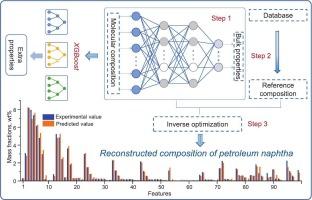通过数据驱动建模和可解释优化的石脑油馏分分子组成重建
IF 4.3
2区 工程技术
Q2 ENGINEERING, CHEMICAL
引用次数: 0
摘要
石油馏分分子组成重建模型在现代炼油厂工艺改造中具有重要的应用价值。在传统的数据驱动重构框架中,从低维体性质到高维分子组成的不确定映射和有限的可解释性仍然是突出的挑战。本研究提出了一种将数据驱动建模与可解释优化相结合的石脑油馏分分子组成重构新策略。预先训练前馈神经网络(FNN)来映射分子组成和体性质。对于每个要重建的样本,参数化的FNN然后嵌入到一个逆优化问题中以重建分子组成。此外,从数据库中构建样品特定的参考成分,以及碳数分布和结构分布剖面,以指导重建,确保化学合理性和与实际石油成分的相似性。重建的成分具有较高的精度。使用SHapley加性解释(SHAP)的模型可解释性分析表明,选择关键的体属性有助于在成分和属性之间建立稳健和无偏的映射。此外,使用有限的关键属性及其重构组成作为输入,通过补充极端梯度增强模型预测了更广泛的体属性集。本文章由计算机程序翻译,如有差异,请以英文原文为准。

Molecular composition reconstruction of naphtha fractions through data-driven modeling and interpretable optimization
Molecular composition reconstruction models for petroleum fractions is important for the application in the process upgrading of modern refineries. In the traditional data-driven reconstruction framework, the underdetermined mapping from low-dimensional bulk properties to high-dimensional molecular compositions and the limited interpretability remain prominent challenges. In this study, a novel strategy is proposed for molecular composition reconstruction of naphtha fractions by integrating data-driven modeling with interpretable optimization. A feedforward neural network (FNN) is pre-trained to map molecular composition to bulk properties. For each sample to be reconstructed, the parameterized FNN is then embedded into an inverse optimization problem to reconstruct the molecular composition. Furthermore, a sample-specific reference composition is constructed from the database to guide the reconstruction, along with carbon number distribution and structural distribution profiles, ensuring chemical plausibility and similarity to realistic petroleum compositions. The reconstructed compositions demonstrate high accuracy. Model interpretability analysis using SHapley Additive exPlanations (SHAP) demonstrates that selecting key bulk properties facilitates the establishment of a robust and unbiased mapping between composition and properties. Furthermore, a broader set of bulk properties are predicted by a supplementary extreme gradient boosting model using limited key properties and its reconstructed composition as inputs.
求助全文
通过发布文献求助,成功后即可免费获取论文全文。
去求助
来源期刊

Chemical Engineering Science
工程技术-工程:化工
CiteScore
7.50
自引率
8.50%
发文量
1025
审稿时长
50 days
期刊介绍:
Chemical engineering enables the transformation of natural resources and energy into useful products for society. It draws on and applies natural sciences, mathematics and economics, and has developed fundamental engineering science that underpins the discipline.
Chemical Engineering Science (CES) has been publishing papers on the fundamentals of chemical engineering since 1951. CES is the platform where the most significant advances in the discipline have ever since been published. Chemical Engineering Science has accompanied and sustained chemical engineering through its development into the vibrant and broad scientific discipline it is today.
 求助内容:
求助内容: 应助结果提醒方式:
应助结果提醒方式:


